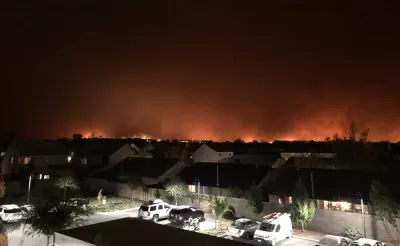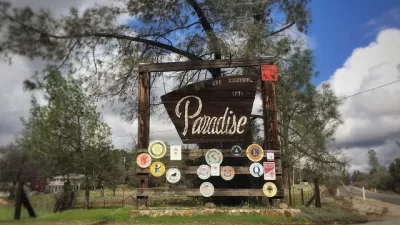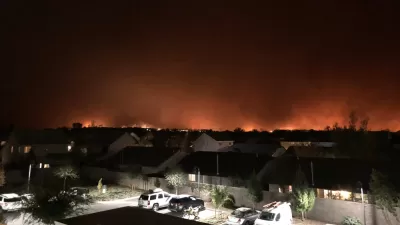The planning history of Paradise, California is blamed for the destruction of the city in the Camp Fire. Can planners find new models for both limiting carbon emissions and preparing for the effects of climate change?

A bombshell feature by the reporting team of Paige St. John, Joseph Serna, and Rong-Gong Lin II reveals the role of poor planning in the destruction and carnage of the Camp Fire in the city of Paradise, California in November.
Without flinching, the beginning of the story sets the stage in stark terms:
The fate of Paradise was cast long before a windstorm last month fueled the deadliest fire in California history.
The ridge settlement was doomed by its proximity to a crack in the mighty wall of the Sierra Nevada, a deep canyon that bellowed gale-force winds.
It was doomed by its maze of haphazard lanes and dead-end roads that paid no heed to escape.
An earlier article published in the Los Angeles Times about how the city's emergency preparation saved potentially thousands of lives is quickly swept under the rug in this telling of the story of the Camp Fire. This Los Angeles Times investigation "found that Paradise ignored repeated warnings of the risk its residents faced, crafted no plan to evacuate the area all at once, entrusted public alerts to a system vulnerable to fire, and did not sound citywide orders to flee even as a hail of fire rained down."
The most damning findings of this investigation are directed toward the land use and transportation concepts that both placed the city in harm's way and then cut off residents from reasonable hope of escape. One potentially contentious focus of the investigation is a nearly decade-old project to narrow the main evacuation route in the city, the Skyway, due to concerns about a spate of pedestrian injuries.
FULL STORY: Here's how Paradise ignored warnings and became a deathtrap

Planetizen Federal Action Tracker
A weekly monitor of how Trump’s orders and actions are impacting planners and planning in America.

San Francisco's School District Spent $105M To Build Affordable Housing for Teachers — And That's Just the Beginning
SFUSD joins a growing list of school districts using their land holdings to address housing affordability challenges faced by their own employees.

The Tiny, Adorable $7,000 Car Turning Japan Onto EVs
The single seat Mibot charges from a regular plug as quickly as an iPad, and is about half the price of an average EV.

Seattle's Plan for Adopting Driverless Cars
Equity, safety, accessibility and affordability are front of mind as the city prepares for robotaxis and other autonomous vehicles.

As Trump Phases Out FEMA, Is It Time to Flee the Floodplains?
With less federal funding available for disaster relief efforts, the need to relocate at-risk communities is more urgent than ever.

With Protected Lanes, 460% More People Commute by Bike
For those needing more ammo, more data proving what we already knew is here.
Urban Design for Planners 1: Software Tools
This six-course series explores essential urban design concepts using open source software and equips planners with the tools they need to participate fully in the urban design process.
Planning for Universal Design
Learn the tools for implementing Universal Design in planning regulations.
Smith Gee Studio
City of Charlotte
City of Camden Redevelopment Agency
City of Astoria
Transportation Research & Education Center (TREC) at Portland State University
US High Speed Rail Association
City of Camden Redevelopment Agency
Municipality of Princeton (NJ)





























